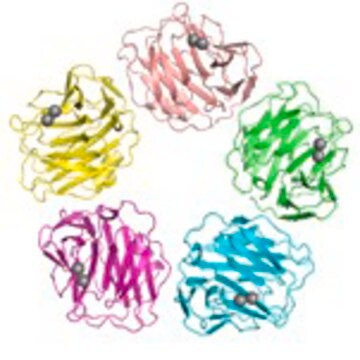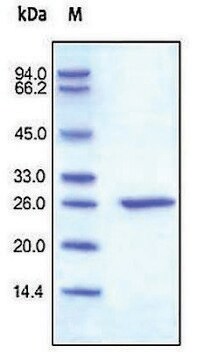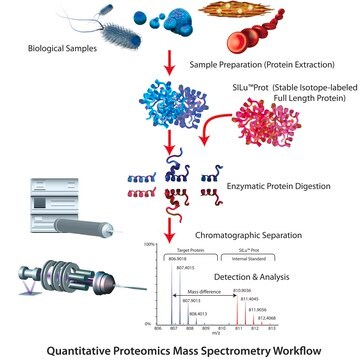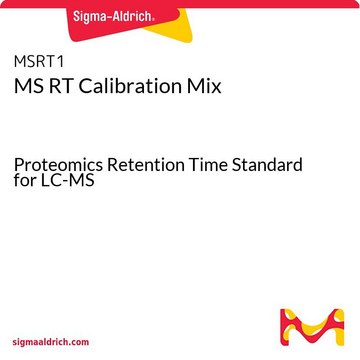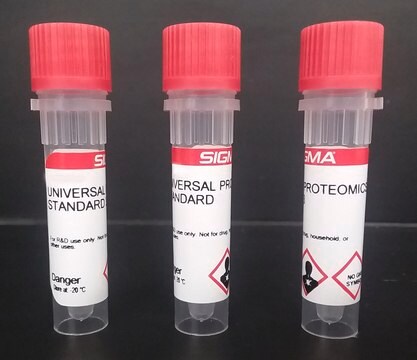MSST0022
SILu™Lite CRP C-reactive Protein human
recombinant, expressed in HEK 293 cells, MS Protein Standard
Sinonimo/i:
PTX1, pentaxin, pentraxin
Autenticatiper visualizzare i prezzi riservati alla tua organizzazione & contrattuali
About This Item
Codice UNSPSC:
23201100
NACRES:
NA.12
Prodotti consigliati
Origine biologica
human
Livello qualitativo
Ricombinante
expressed in HEK 293 cells
Saggio
≥98% (SDS-PAGE)
Stato
liquid
tecniche
mass spectrometry (MS): suitable
Compatibilità
suitable for mass spectrometry (internal calibrator)
N° accesso UniProt
Temperatura di conservazione
−20°C
Informazioni sul gene
human ... PTX3(5806)
Categorie correlate
Descrizione generale
SILu™Lite CRP is a recombinant human protein expressed in human 293 cells. It is a protein consisting of 226 amino acids (including a C-terminal polyhistidine and FLAG® tags), with a calculated molecular weight of ~25 kDa. SILu™Lite CRP is an analytical standard designed to be used as starting material for preparation of calibrators and controls in LC-MS applications.
Suggested Quantitative Analysis Parameters
(MRM settings provided for three suggested peptides)
Suggested Quantitative Analysis Parameters
(MRM settings provided for three suggested peptides)
Azioni biochim/fisiol
CRP is a hepatically derived pentraxin. It exists mainly as a pentamer in a cyclic structure with 5 identical 23-kD subunits in the blood. In addition to its role as an "acute phase" protein or first-line defense molecule against pathogenic organisms, baseline levels of CRP correlate positively to adverse cardiovascular events. CRP is therefore being considered a “risk factor” for cardiovascular disease. In humans, treatment with statin therapy reduces levels of both LDL-C and CRP, and concurrently there is a reduction in the number of cardiovascular events. A recent study suggests that patients with elevated basal levels of CRP are at an increased risk of diabetes, in addition to cardiovascular disease. A study of over 700 nurses showed that those in the highest quartile of trans fat consumption had blood levels of CRP that were 73% higher than those in the lowest quartile.
Sequenza
QTDMSRKAFVFPKESDTSYVSLKAPLTKPLKAFTVCLHFYTELSSTRGYSIFSYATKRQDNEILIFWSKDIGYSFTVGGSEILFEVPEVTVAPVHICTSWESASGIVEFWVDGKPRVRKSLKKGYTVGAEASIILGQEQDSFGGNFEGSQSLVGDIGNVNMWDFVLSPDEINTIYLGGPFSPNVLNWRALKYEVQGEVFTKPQLWPDYKDDDDKGHHHHHHHHGGQ
Stato fisico
Supplied as a solution of phosphate buffered saline with 25% glycerol.
Note legali
FLAG is a registered trademark of Merck KGaA, Darmstadt, Germany
SILu is a trademark of Sigma-Aldrich Co. LLC
Codice della classe di stoccaggio
10 - Combustible liquids
Classe di pericolosità dell'acqua (WGK)
WGK 1
Punto d’infiammabilità (°F)
Not applicable
Punto d’infiammabilità (°C)
Not applicable
Scegli una delle versioni più recenti:
Certificati d'analisi (COA)
Lot/Batch Number
Non trovi la versione di tuo interesse?
Se hai bisogno di una versione specifica, puoi cercare il certificato tramite il numero di lotto.
Possiedi già questo prodotto?
I documenti relativi ai prodotti acquistati recentemente sono disponibili nell’Archivio dei documenti.
Steven E Nissen et al.
The New England journal of medicine, 352(1), 29-38 (2005-01-07)
Recent trials have demonstrated better outcomes with intensive than with moderate statin treatment. Intensive treatment produced greater reductions in both low-density lipoprotein (LDL) cholesterol and C-reactive protein (CRP), suggesting a relationship between these two biomarkers and disease progression. We performed
R P Tracy et al.
Arteriosclerosis, thrombosis, and vascular biology, 17(10), 2167-2176 (1997-11-14)
Blood levels of C-reactive protein (CRP), a marker of inflammation, are related to cardiovascular disease risk. To determine cross-sectional correlates in the elderly, we measured CRP in 400 men and women older than 65 years and free of clinical cardiovascular
Esther Lopez-Garcia et al.
The Journal of nutrition, 135(3), 562-566 (2005-03-01)
Trans fatty acid intake has been associated with a higher risk of cardiovascular disease. The relation is explained only partially by the adverse effect of these fatty acids on the lipid profile. We examined whether trans fatty acid intake could
A D Pradhan et al.
JAMA, 286(3), 327-334 (2001-07-24)
Inflammation is hypothesized to play a role in development of type 2 diabetes mellitus (DM); however, clinical data addressing this issue are limited. To determine whether elevated levels of the inflammatory markers interleukin 6 (IL-6) and C-reactive protein (CRP) are
Il team dei nostri ricercatori vanta grande esperienza in tutte le aree della ricerca quali Life Science, scienza dei materiali, sintesi chimica, cromatografia, discipline analitiche, ecc..
Contatta l'Assistenza Tecnica.